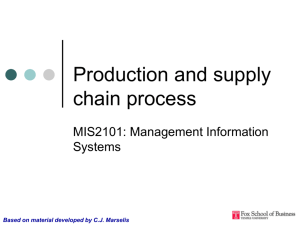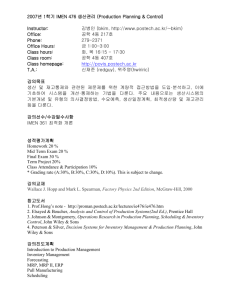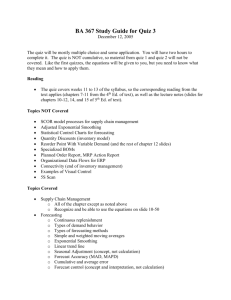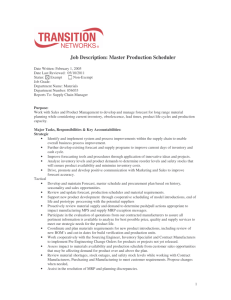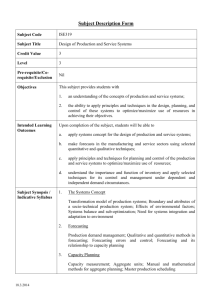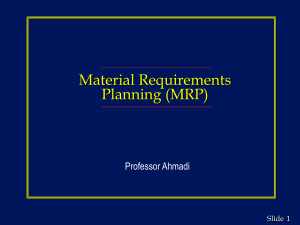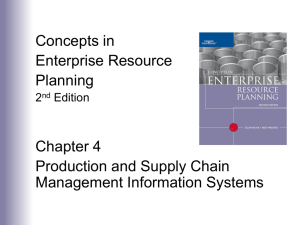Class-9-Supply-Chain
advertisement
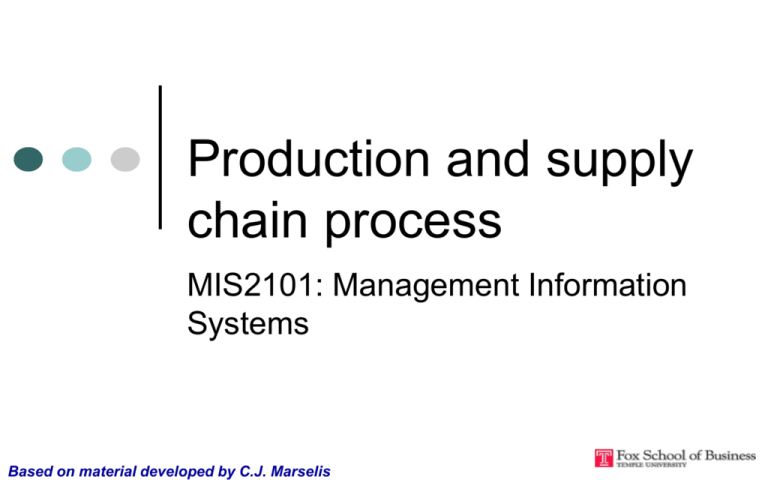
Production and supply chain process MIS2101: Management Information Systems Based on material developed by C.J. Marselis At Fitter Snacker, production manager schedules production based on experience, rather than formal planning techniques MRP and ERP What is MRP and what does it have to do with ERP? Facilitating the production plan What kind of questions does the production plan answer? A successful company must be able to Develop a good production plan Execute the plan Make adjustments when customer demand differs from the forecast Production Approaches Make to Stock Make to Order Assemble to order Produces 200 bars/minute, 3,000 lb/hr Mixer Mixer Snack Bar Line Form Bake Pack Mixer Mixer Operates 1 8-hour shift per day Changing from NRG-A to NRG-B bars takes 30 minutes Finished Goods Warehouse Raw Material Warehouse Mixes 4,000 lbs/hr Excess capacity to ensure line doesn’t shutdown Production Problems in “Unintegrated” systems Communication Inventory Accounting What are some of these problems? Production planning process What are the major steps in the production planning process? Sales Forecasting Starting Inventory Sales and Operations Planning Demand Management Detailed Scheduling MRP Production Purchasing An integrated process Predicts future demand for products Sales Forecasting Starting Inventory Sales and Operations Planning Break production plan down into smaller time increments Create production schedule based on production plan from demand management Uses the schedule to 9 determine products and staffing Demand Management Determines what company should produce Requires starting inventory levels and sales forecast based on capacity Determines amount and timing of raw material orders Detailed Scheduling MRP Production Purchasing Takes quantity and timing information from MRP and creates orders for suppliers Sales Forecasting Starting Inventory Sales and Operations Planning Demand Management Detailed Scheduling Production MRP Purchasing 10 Simple Sales Forecast In an integrated system, where do I get the information to support my sales forecast? Sales Forecasting Previous Year (cases) Promotion Sales (cases) Previous Year base (cases) Growth: 3.0% Base Projection (cases) Promotion (cases) Sales Forecast (cases) Jan. 5734 Feb. 5823 March 5884 April 6134 5734 172 5906 5823 175 5998 5884 177 6061 6134 184 6318 May 6587 300 6287 189 6476 5906 5998 6061 6318 6476 June 6735 300 6435 193 6628 500 7128 Sales and operations planning – SOP or S&OP What question does S&OP answer? Sales Forecasting Previous Year (cases) Promotion Sales (cases) Previous Year base (cases) Growth: 3.0% Base Projection (cases) Promotion (cases) Sales Forecast (cases) Sales and Operations Planning 1) Sales Forecast 2) Production Plan 3) Inventory 4) Working Days 5) Capacity (Shipping Cases) 6) Utilization 7) NRG-A (cases) 70.0% 8) NRG-B (cases) 30.0% Jan. 5734 Feb. 5823 March 5884 April 6134 5734 172 5906 5823 175 5998 5884 177 6061 6134 184 6318 May 6587 300 6287 189 6476 5906 5998 6061 6318 6476 Dec. 100 Jan. 5906 5906 100 22 7333 81% 4134 1772 Feb. 5998 5998 100 20 6667 90% 4199 1799 March 6061 6061 100 22 7333 83% 4243 1818 April 6318 6318 100 21 7000 90% 4423 1895 May 6476 6900 524 23 7667 90% 4830 2070 June 6735 300 6435 193 6628 500 7128 June 7128 6700 96 21 7000 96% 4690 2010 Demand Strategies If demand is greater than capacity… Option Result Choose not to meet the demand Lost sales Reduce promotional expenditures Potential lost sales Use overtime to increase capacity Increased costs Build up inventory in earlier periods 35 30 25 20 Supply Increased costs and lost inventory 15 Capacity 10 5 0 Time Forecasting in an Integrated System Accurate historical sales values available for forecasting “Fix” historical sales: If production was unable to meet demand sales does NOT represent actual demand Unusual conditions like weather The effect of sales promotions Sales provided from SD module Field where planner can “correct” the sales value Sales and Operations Planning (SOP) Case Study Kellogg’s achieved significant savings from coordinated sales and operations planning (SOP) Changed focus based on how they were evaluated Marketing and sales: Evaluated on tons of cereal sold Manufacturing: Evaluated on tons of cereal produced No one evaluated on profit! Kellogg’s new sales order process focused on profit Kellogg’s has reduced capacity, inventory and capital needs while increasing sales Sales Forecasting Starting Inventory Sales and Operations Planning Demand Management Detailed Scheduling Production MRP Purchasing 16 Demand Management What does “Demand Management” do? Demand Management Monthly Demand NRG-A NRG-B Working Days in Week Working Days in Month MPS NRG-A Weekly Demand NRG-B Week 1 1/2 - 1/5 4134 1772 4 22 752 322 4 4134 752 22 4 1772 322 22 4/22 represents how many work “weeks” are in each month Sales Forecasting Starting Inventory Sales and Operations Planning Demand Management Detailed Scheduling Production MRP Purchasing 18 Bill of Material What is a BOM? Ingredient Oats (lb) Wheat germ (lb) Cinnamon (lb) Nutmeg (lb) Cloves (lb) Honey (gal) Canola Oil (gal) Vit./Min. Powder (lb) Carob Chips (lb) Raisins (lb) Protein Powder (lb) Hazelnuts (lb) Dates (lb) Quantity NRG-A NRG-B 300 250 50 50 5 5 2 2 1 1 10 10 7 7 5 5 50 50 50 30 70 Lead Times and Lot Sizing When it comes to purchasing raw materials, what are… “Lead Times”? “Lot Sizes” and why do I care? Purchasing and ERP What benefits do I get if my production planning system is integrated with my procurement system? Convert MRP data to a purchase order Options to evaluate vendors Production and Accounting in an Integrated System What benefits do I get when my production systems are integrated with my accounting systems? Material received (for MRP) and the purchase order Implications for Supply Chain Management How quickly does information flow from the retailer all the way back to the raw materials suppliers when demand changes in: Non-integrated system? Integrated system? $ Goods Goods Supplier Information $ $ Goods Manufacturer Information $ $ Goods Wholesaler Information Information Goods Retailer Information Customer Raw Materials Supply Chain Integration What kind of benefits do I get when I integrate my supply chain with my “partners”? Top Line Versus Bottom Line Where do Supply Chain Systems add value? Inventory Control Case Study – Hoyt Archery Pre ERP, complete inventory count two times each year Closed plant for 3 days at cost of $5000 /day Post ERP, accurate, real-time inventory information and ongoing cycle- counting process: items are counted each day Hoyt also simplified customer interaction with its configure-to-order (CTO) process SCM with Customer Collaboration Case Study – Wal-Mart POS data from bar code scanners is recorded in a massive data warehouse at Wal-Mart headquarters Wal-Mart uses data mining techniques to predict what customers will buy at different times of the year Data is shared with Wal-Mart suppliers to plan production Wal-Mart also allows its 5000 suppliers to directly access its data warehouse through its Retail Link program Wal-Mart is leading the effort to leverage RFID technology SCM Critical Success Factors Business-driven strategy – Focus on customer Management Commitment – From the business and IT, not an IT project! Supplier/Partner Expectation Management Internal Expectation Management Learning Period Acceptance Summary An ERP system can improve the efficiency of production and purchasing processes Begins with Marketing sharing sales forecast Production plan is created based on forecast and shared with Purchasing so raw materials can be ordered properly. Production planning can be done without an integrated system, but integrated system that allows MRP and Production to be linked to Purchasing and Accounting
